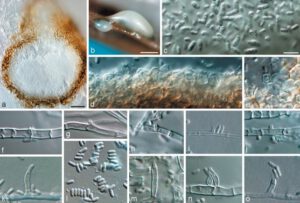Aequabiliella effusa (Damm & Crous) Crous, Persoonia 34: 225 (2015)
Index Fungorum Number: IF 812476; MycoBank Number: MB 812476; Facesoffungi Number: FoF 15736
Basionym: Phaeomoniella effusa Damm & Crous, Persoonia 24: 75. 2010.
Etymology. Named after the effuse growth of the colonies (effusus Lat. = effuse).
Vegetative hyphae hyaline, 1–3 μm wide, smooth-walled, lacking chlamydospores. Sporulation abundant; conidia formed on hyphae and in pycnidia. Conidiophores on hyphae mainly reduced to conidiogenous cells, few 2-celled conidiophores, sub-cylindrical to navicular, 12–22 × 2 μm. Conidiogenous cells enteroblastic, discrete phialides rare, mostly reduced to very short adelophialides or more often with collarettes formed directly on hyphal cells; with cylindrical to conical necks, 1.5–3 × 1–2 μm, distinct phialides navicular or elongate-ampulliform and attenuated at the base, 7–12 × 2 μm; collarettes and periclinal thickening conspicuous, collarettes cylindrical to narrowly funnel-shaped, thin-walled, 0.5–2 long, opening 0.5–1 μm wide. Conidia aggregated in masses around the hyphae, hyaline, 1-celled, cylindrical to obovate, sometimes slightly curved, both ends obtuse, smooth-walled, containing small droplets, (2–)2.5–3.5(–4.5) × 1–1.5 μm, mean ± SD = 3.0 ± 0.6 × 1.2 ± 0.1 μm, L/W ratio = 2.4. Microcyclic conidiation not observed. Conidiomata pycnidial, produced on pine needles on SNA and on MEA in 2–4 wk; on pine needles solitary, subglobose, superficial, 100–350 μm wide, unilocular, opening by irregular rupture, wall composed of brown textura angularis. Conidiophores reduced to conidiogenous cells. Conidiogenous cells enteroblastic, hyaline, broadly ellipsoidal, somewhat angular, resembling wall cells, 3–5 × 4–6 μm; opening 0.5 μm, periclinal thickening as a broad ring around opening, collarette very short or inconspicuous. Conidia hyaline, 1-celled, cylindrical, sometimes slightly curved, both ends obtuse, smooth-walled, containing small droplets, (2–)2.5–5(–6) × 1–2 μm, mean ± SD = 3.5 ± 0.7 × 1.5 ± 0.2 μm, L/W ratio = 2.3.
Culture characteristics — Colonies on PDA flat, moist, with sparse aerial mycelium in the centre and undulate to lobate margin; herbage-green, dark herbage-green to olivaceous, white at the margin and sometimes in the centre; on MEA flat, moist, with radial growth rings, very little villose, olivaceous-grey aerial mycelium, with entire margin; olivaceous-grey to pale olivaceous-grey; 32 mm diam in 2 wk (25 °C dark), min 5 °C, max 35 °C, opt 30 °C.
Specimen examined – South africa, Western Cape Province, Paarl, from necrosis in wood of P. persica, 10 June 2004, U. Damm, CBS H-19998 holotype, culture ex-type CBS 120883 = STE-U 6121.

Figure 1 – Aequabiliella effusa. a. Longitudinal section through a pycnidium; b. conidia oozing from pycnidium on pine needle; c. conidia formed in pycnidia; d, e. conidiogenous cells lining the inner wall of pycnidia; f–k, m–o. conidiogenous cells on hyphal cells; l. conidia formed on hyphal cells. All from ex-type culture CBS 120883. a, c–o: DIC; b: DM. — Scale bars: a = 20 μm; b = 500 μm; c = 5 μm; c applies to c–o.
